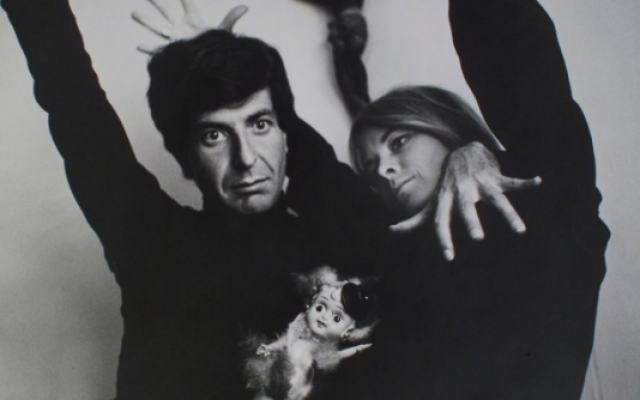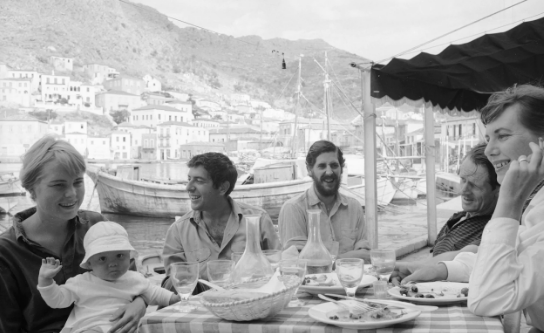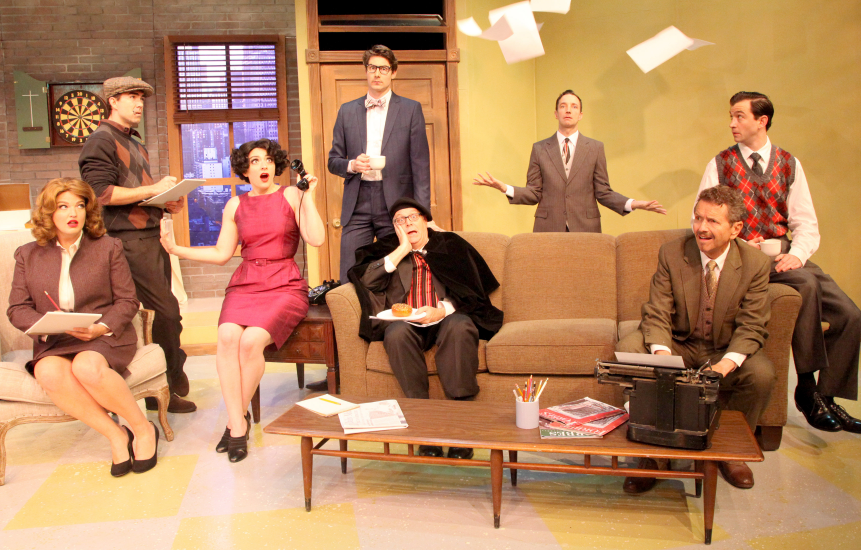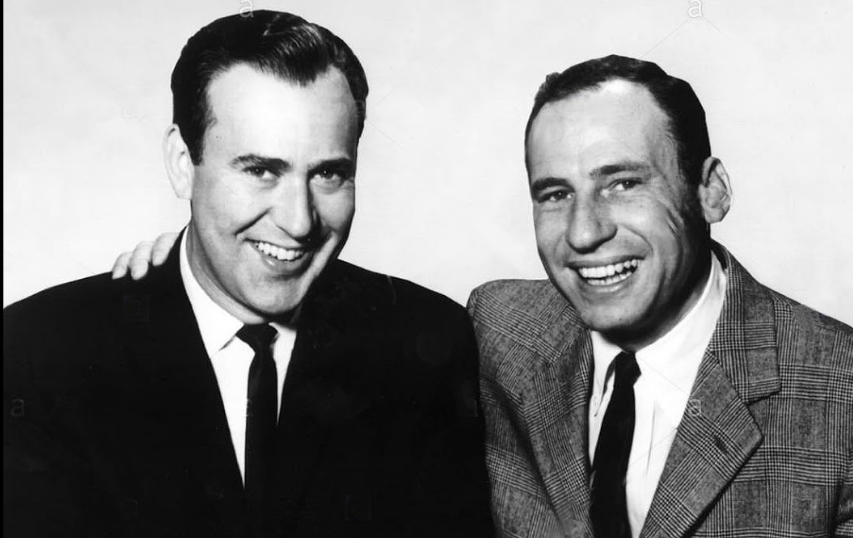Jewish Culture This Week
If you’re looking for culture in Atlanta, you’ll find it in two productions of iconic Jewish performers shown at local theaters.

If you’re looking for culture in Atlanta, you’ll find it in two productions of iconic Jewish performers shown at local theaters. Through the next week you can view a new film about the love life of singer-songwriter Leonard Cohen and a play by Neil Simon recapturing the heyday of Borscht Belt comedians such as Sid Caesar and Carl Reiner. Read more about those productions here:
The Seductive Leonard Cohen
Seductive is probably as good a word as any to describe the new film about Leonard Cohen and his friend, lover and artistic inspiration, Marianne Ihlen, which opens July 26 at the Midtown Art Cinema.
The film, “Marianne and Leonard – Words of Love,” was written and directed by the English documentary filmmaker Nick Broomfield. It first lures us in by introducing us to the charms of the beautiful Greek island of Hydra.
It was there in 1960 that a young novelist and poet, Leonard Cohen, fell in love with the simple natural beauty of the place. Once smitten, it didn’t take long to find there a young, blond Norwegian beauty to share his life and his love. Although they were together only about seven years, for the next 56 years, they shared an on-again, off-again relationship that lasted until both of their deaths in 2016.
Cohen, who grew up in a prominent and wealthy Jewish family in Montreal, finds in the easy, sunny life among the artists and writers in Hydra the inspiration to complete his first novel and face some of the more urgent questions that surround his commitment to writing.
With the help of the romantic muse that he found in his new home, he makes the slow and inexorable journey to a new identity. He becomes Leonard Cohen, poet, songwriter and inevitably, world-famous performer. The film is a thoughtful and compelling record of that transformation and the forces of seduction it unleashes.
With his handsome and strongly Semitic features, his soulful gaze and his mournful voice, he became almost irresistible to the women that crowded his public performances. He sang “So Long, Marianne” over and over to the crowds, as well as several others she had inspired him to write. There is in one telling scene an effort by an attractive fan to seduce the young Cohen, despite the presence of the woman’s male companion and a film camera that is recording the entire sequence.
Later he describes his appeal to women with same kind of bluntness that he brought to much of his creative work. It is, after all, not all his fault, he maintains, it was the swinging 60s.
“For a tiny moment in social history there was a tremendous cooperation between men and women, so I was very lucky my appetite coincided with a very rare phenomenon.”
Eventually his career and his fame kept him apart from Marianne, as he put it, for six months of the year. Then they would only be together for four months, then only for two months, then only two days of the year. His song about the breakup was an early favorite of the crowds of new fans that were drawn to him. He sings it in the film at the historic Isle of Wight music festival.
Eventually, Ihlen also left Hydra behind. She went back to Norway, became a secretary, married an engineer and had three children with him. Through the years, Cohen saw himself transformed from just an attractive Jewish songwriter into a living legend.

His homage to King David, the lengthy anthem “Hallelujah,” became one of the most recorded songs in history. He made and lost a fortune, then gained it all back again. Through everything, he never lost touch with the woman that had made such a difference in his life.
He learned toward the end of his life that his great love was dying of leukemia and had only a few days to live. Even though he was himself in great pain and suffering from cancer in his back, he took some time to write her in time for her to have it read to her in Norway before she died.
The letter read:
“Well Marianne, it’s come to this time when we are really so old and our bodies are falling apart and I think I will follow you very soon. Know that I am so close behind you that if you stretch out your hand, I think you can reach mine.
And you know that I’ve always loved you for your beauty and for your wisdom, but I don’t need to say anything more about that because you know all about that. But now, I just want to wish you a very good journey.
Goodbye old friend. Endless love, see you down the road.”
Ihlsen stretched out her hand and two days later she died. Cohen died not long after, on November 7, 2016, in Los Angeles.
“Marianne and Leonard: Words of Love” is playing at the Midtown Art Cinema, 931 Monroe Drive, through Aug. 1.
‘Laughter on the 23rd Floor’ Recalls Early TV Comedy
Before there were such programs as “Shtisel,” “The Marvelous Mrs. Maisel” and “Seinfeld,” before the Jewish comedic mind created the gold-plated bedrock of the American entertainment industry, there was “Your Show of Shows.”
The program was created by Max Liebman, who had just a few years before been producing weekly summer comedy shows in the Jewish Pocono resort circuit of Pennsylvania. Its star was Sid Caesar, who started out as a professional saxophonist before becoming a standup comedian in the Borscht Belt.
Backing up Caesar were two important Jewish entertainers, Howard Morris and Carl Reiner, who had lengthy careers in the industry, and Imogene Coca, whose cool, thoughtful comedy style perfectly complimented the manic pace of the show.
Today “Your Show of Shows” is remembered mostly by television historians and connoisseurs of a good laugh, but in the early 1950s, when it was broadcast on NBC, it was one of the biggest hits of early television. At a time when the new medium was looking for ways to reach the rapidly growing audience in America’s living rooms, a group of mostly Jewish comedy geniuses were creating a weekly national laugh riot.
Those days are recalled in a new production by the Stage Door Players in Dunwoody of “Laughter on the 23rd Floor,” originally written in 1993 by Neil Simon, who also wrote a film version in 2001. It runs through Aug. 4.

The play, by one of the most successful comedy script writers in film and stage history, recalls the days when a group of Jewish comedy writers faced the challenge of producing big laughs week in and week out. “Your Show of Shows,” starring Sid Caesar, was broadcast live for 1 ½ hours each Saturday night from 1950 to 1954.
In the production by the Stage Door Players, Caesar, renamed Max Prince, oversees the writers’ room on the weekly show. The veterans of that grueling routine and the other shows in which Caesar starred would later go on to become household names in the entertainment industry.

Among them was the head writer Mel Tolkin, Mel Brooks, Woody Allen, Neil and Danny Simon, and Larry Gelbart, creator of the long running TV hit, M*A*S*H., all of whom had gone on to long and profitable careers.
Simon’s play is not the best work of this Pulitzer Prize winning writer. It is a mostly tepid memoir of what must have been a feverish hothouse atmosphere, watched over by the comic genius, Sid Caesar.
Still, the play does get one thing right, the pressure of early television to dumb-down entertainment for its rapidly growing audience. When the network wants to cut the budget for the show and lay off one of the writers, Max suggests that they all go on strike.
But one of the writers quickly sets him straight, “They have corporate minds, Max. If they could get a TV set to turn out sausages, we’d all be pigs instead of writers,” he says. “They’re not interested in culture. Maybe if Van Gogh and Goya were wrestlers, they’d put them on Friday nights. But if we quit, Max, they win. We give up an hour and a half to ‘Miss America’ and ‘Beat the Clock.’ We stay, Max. We do what we’ve been doing for years. Only we do it better.”
That’s largely what “Your Show of Shows” did. The program combined broad slapstick with occasional delicate moments of pantomime and deft strokes of satire and brilliant parody to create some of the funniest programs ever broadcast. There were brilliant sendups of “Pagliacci” opera and the popular early TV series, “This Is Your Life.” One sketch recalls the silent German film classics of F.W. Murnau, another, Japanese art house films.
Many program segments didn’t survive the live broadcast era of the 1950s, but a few sketches can be glimpsed on YouTube or on the several DVD collections that are available for sale online. If you can’t get to the Stage Door Players production, which runs through Aug. 4, you have some hilarious alternatives.
Bob Bahr teaches a class entitled “Anything For a Laugh – American Comedy and The American Jewish Soul,” at The Temple this fall.



comments